
RS Aggarwal Solutions for Class 8 Maths Chapter 1 Exercise 1.6: The Physics Wallah academic team has produced a comprehensive answer for Chapter 1: Rational Numbers in the RS Aggarwal class 8 textbook. The RS Aggarwal class 8 solution for Chapter 1 Rational Numbers Exercise-1F is uploaded for reference only; do not copy the solutions.
Before going through the solution of chapter-1 Rational Numbers Exercise-1F, one must have a clear understanding of chapter-1 Rational Numbers. Read the theory of Chapter 1 Rational Numbers and then try to solve all numerical of exercise-1F. Read the NCERT maths textbook and use the NCERT class 8 maths solutions to answer the exercise questions if you want to become an expert in the subject. Experts in Physics Wallah have compiled all of the NCERT Solutions.RS Aggarwal Solutions for Class 8 Maths Chapter 1 Exercise 1.6 Rational Numbers Overview
Chapter 1 of RS Aggarwal's Class 8 Maths book focuses on Rational Numbers, a fundamental topic in mathematics. Exercise 1.6 is dedicated to enhancing students' understanding of rational numbers through various problems and examples. This exercise aims to solidify the concept of rational numbers, which are numbers that can be expressed in the form of p/q, where p and q are integers, and q is not equal to zero. The problems in this exercise involve operations like addition, subtraction, multiplication, and division of rational numbers. Additionally, students learn to simplify rational expressions and solve equations involving rational numbers. Through step-by-step solutions, students can see how to approach each problem methodically, ensuring they grasp the underlying principles. This exercise not only helps in reinforcing basic arithmetic skills but also prepares students for more complex algebraic concepts. The solutions provided in RS Aggarwal's book are comprehensive, offering clear explanations and logical steps to solve each problem.RS Aggarwal Solutions for Class 8 Maths Chapter 1 Exercise 1.6 PDF
Below we have provided RS Aggarwal Solutions for Class 8 Maths Chapter 1 Exercise 1.6 Rational Numbers in detail. This chapter will help you to clear all your doubts regarding the chapter. Students are advised to prepare from these RS Aggarwal Solutions for Class 8 Maths Chapter 1 Exercise 1.6 Rational Numbers before the examinations to perform better.RS Aggarwal Solutions for Class 8 Maths Chapter 1 Exercise 1.6 PDF
RS Aggarwal Solutions for Class 8 Maths Chapter 1 Exercise 1.6
Below we have provided RS Aggarwal Solutions for Class 8 Maths Chapter 1 Exercise 1.6 Rational Numbers –(1) From a rope 11 m long, two pieces of lengths 2 (3/5) m and 3 (3/10) m are cut off. What is the length of the remaining rope?
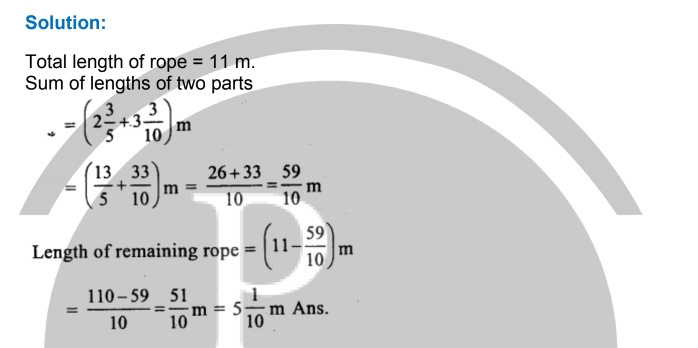
(2) A drum full of rice weighs 40 (1/6) kg. If the empty drum weighs 13 (3/4) kg, find the weight of rice in the drum.
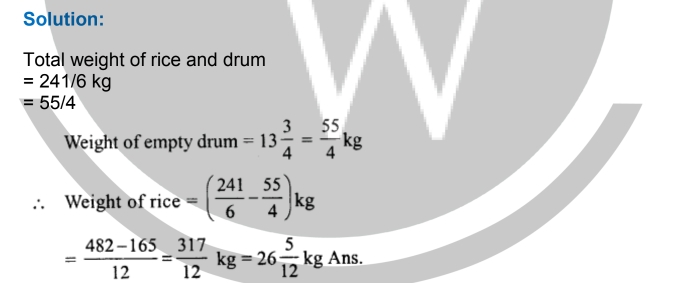
(3) a basket contains three types of fruits weighing 19 1/3 kg in all. If 8 1/9 kg of these be apples, 31/6 kg be oranges and the rest pears, what is the weight of the pears in the basket?
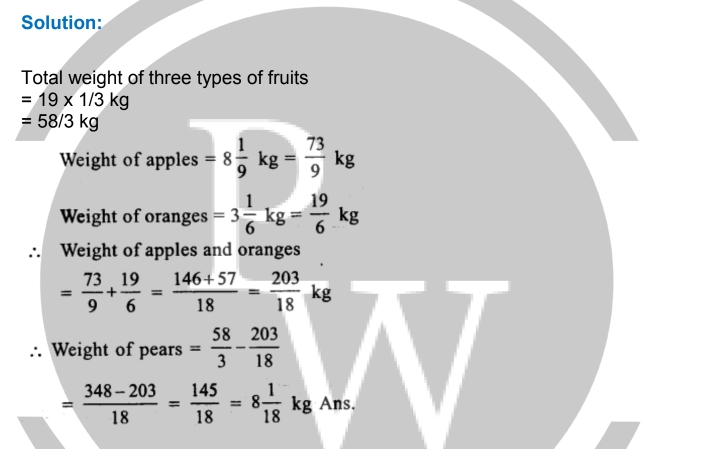
(4) On one day a rickshaw puller earned Rs 160. Out of his earnings he spent Rs 26 (3/5) on tea and snacks, Rs 50 (1/2) on food and Rs 16 (2/5) on repairs of the rickshaw. How much did he save on that day?
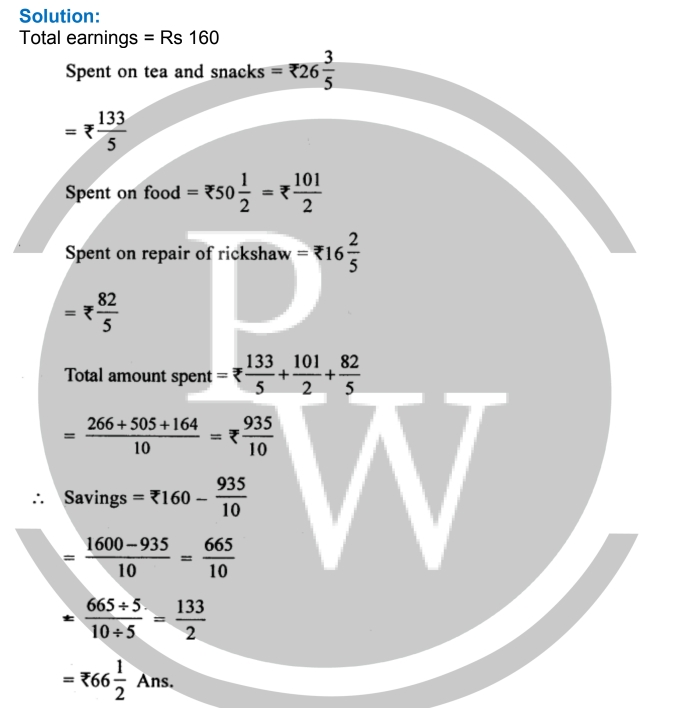
(5) Find the cost of 3 (2/5) metres of cloth at Rs 63 (3/4) per metre.
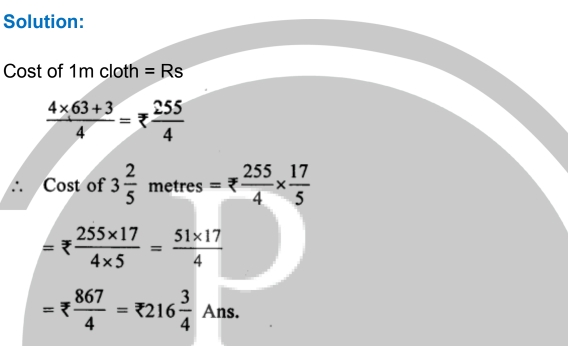
(6) A car is moving at an average speed of 60 (2/5) km/hr. How much distance will it cover in 6 (1/4) hours?

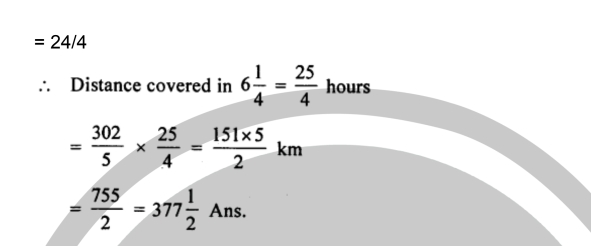
(7) Find the area of a rectangular park which is 36 (3/5) m iong and 16 (2/3) m broad.
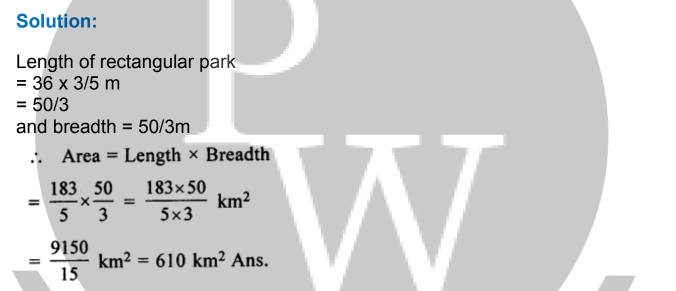
(8) Find the area of a square plot of land whose each side measures 8 (1/2) metres.


(9) One litres of petrol costs Rs 63 (3/4). What is the cost of 34 litres of petrol?
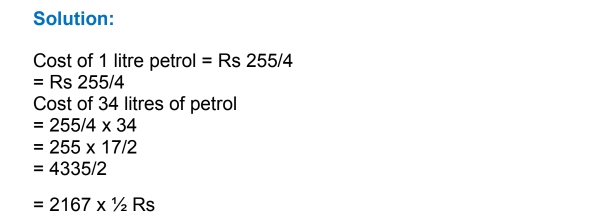
(10) An aeroplane covers 1020 km in an hour. How much distance will it cover in 4 (1/6) hours?

(11) The cost of 3 (1/2) metres of cloth is Rs 166 (1/4). What is the cost of one metre of cloth?

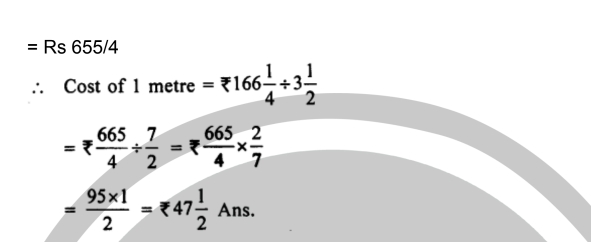
(12) A cord of length 71 (1/2) m has been cut into 26 pieces of equal length. What is the length. What is the length of each piece?
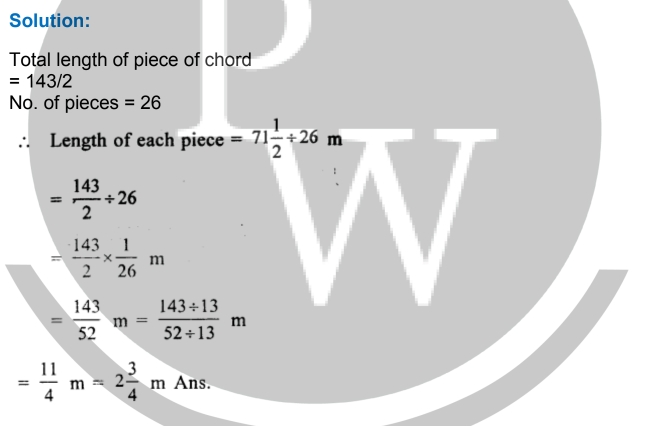
(13) The area of a room is 65 (1/4) m 2 . If its breadth is 5 (7/16) metres, what is its length?
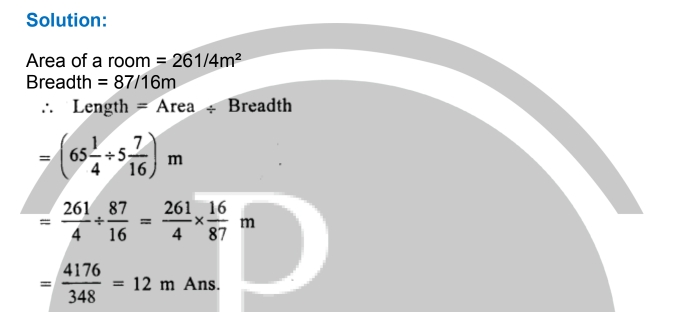
(14) The product of two fractions is 9 3/5. If one of the fractions is 9 (3/7), find the other.

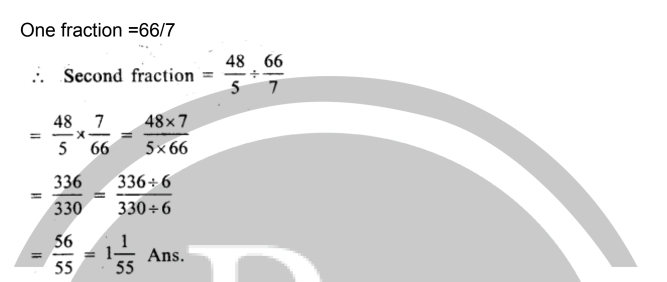
(15) In a school, 5/8 of the students are boys. If there are 240 girls, find the number of boys in the school.

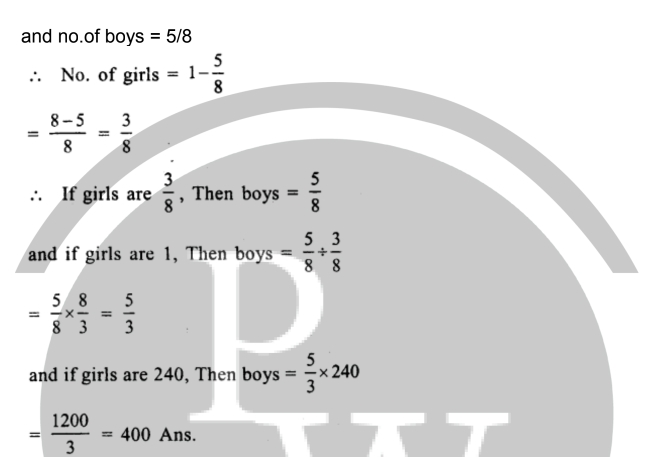
(16) After reading 7/9 of a book, 440 pages are left. How many pages are there in the book?

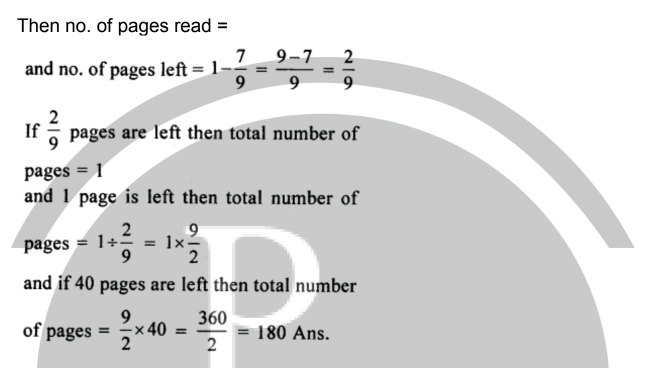
(17) Rita had Rs 300. She spent 1/3 of her money on notebooks and 1/4 of the remainder on stationary items. How much money is left with her?

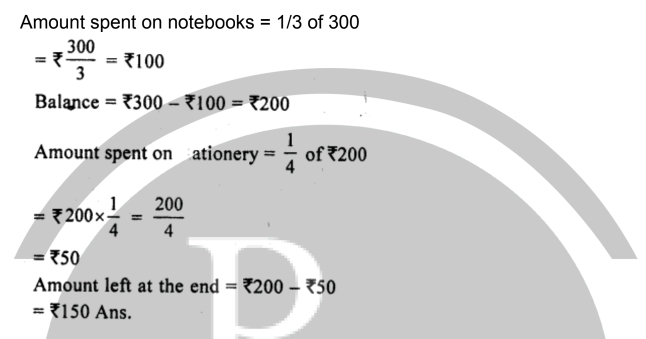
(18) Amit earns Rs 32000 per month. He spends 1/4 of his income on food; 3/10 of the remainder on house rent and 5/21 of the remainder on the education of children. How much money is still left with him?

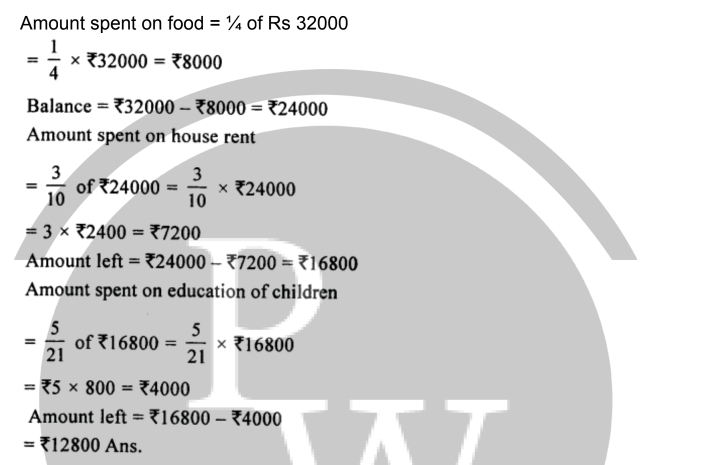
(19) If 3/5 of a number exceeds its 2/7 by 44, find the number.
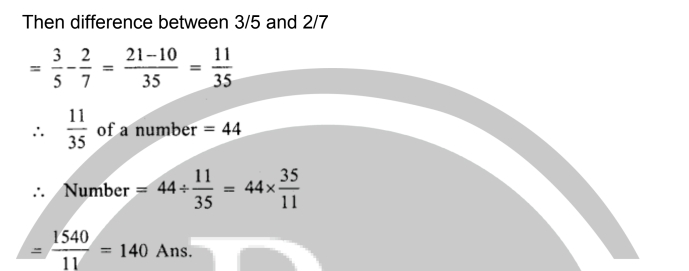
(20) At a cricket test match 2/7 of the spectators were in a covered place while 15000 were in open. Find the total number of spectators.

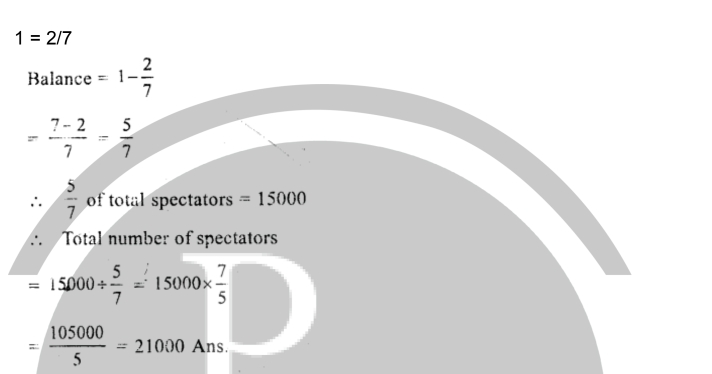
Benefits of RS Aggarwal Solutions for Class 8 Maths Chapter 1 Exercise 1.6
The RS Aggarwal Solutions for Class 8 Maths Chapter 1 Exercise 1.6 on Rational Numbers offer several benefits for students:Concept Clarity : The solutions provide clear, step-by-step explanations for each problem, helping students understand the fundamental concepts of rational numbers.
Comprehensive Coverage : Each type of problem related to rational numbers, including addition, subtraction, multiplication, and division, is covered thoroughly, ensuring that students get ample practice.
Confidence Building : By working through the solutions, students gain confidence in their problem-solving abilities, which is crucial for tackling more complex mathematical concepts in the future.
Error Reduction : Detailed solutions help students identify and correct their mistakes, reducing the likelihood of errors in exams.
Time Management : Practicing with these solutions helps students improve their speed and accuracy, which is essential for performing well in timed exams.
Enhanced Problem-Solving Skills : The solutions encourage logical thinking and analytical skills, as students learn to approach problems methodically.
RS Aggarwal Solutions for Class 8 Maths Chapter 1 Exercise 1.6 FAQs
What topics are covered in Exercise 1.6?
How can RS Aggarwal solutions help in understanding rational numbers?
Are these solutions useful for exam preparation?
Can the solutions help in improving problem-solving skills?









